INTRODUCTION
Aquaculture contributes to the livelihoods of the poor through improved food supply, employment and income opportunities. The Fisheries and Aquaculture Department (FAO) has defined the role of fish aquaculture which contributes to national food self-sufficiency through direct consumption and through trade and exports.
Supposed to be not a major solution for food security, current aquaculture does contribute to overall food supply by increasing the production of popular fish, thus reducing prices and by broadening the opportunities for income and food access (McKinsey, 1998; Sverdrup-Jensen, 1999). Thus aquaculture is indicated to be an important system for local food security through reduced vulnerability to unpredictable natural crashes in aquatic production, improved food availability, improved access to food and more effective food utilization (FAO, 2003a). Furthermore, the role of aquaculture can be assessed by looking at its impact on a variety of different aspects of food security base on core indicators: stability of food supply, availability of food, access for all to supplies and effective biological utilization of food.
The stability of food supply gives people access to adequate food at all times. Comparative trends in traditional agricultural food production with those from aquaculture under different environmental conditions. Quantifying the revenues generated from the aquaculture in comparison with traditional farming methods reveals its significance to food security thank to the vulnerable reduction to natural catastrophes (Williams, 1999). In addition, the percentage of fish farmer’s total income received from aquaculture could also be an important measurement of its role in alleviating hunger and poverty. Besides, aquaculture products are used primarily for foods, then one could imply that aquaculture is important not only in food provision during the most critical periods, but also in providing cheap and accessible food to those most in need (Ali and Delisle, 1999; Maxwell et al., 1999). In reality, the amount of land and water resources required for a quantity of food produced in aquaculture could also be compared to that achieved on land, although species diversity, levels of intensification and the range of products produced may make this evaluation hard. Increasing the supply of fisheries products is not sufficient to improve food security without the assurance of economic, physical and social access to adequate and nutritious food (Kent, 1997; FSIEWS, 2001).
From other perspectives, economic access to food occurs when households generate sufficient income to buy food and nations generate foreign exchange to pay for food imports (Sigot, 1998; Williams, 1999). Moreover, consumption of fish, often a non-staple food, rises rapidly with income on a percentage basis (Bouis, 2000). Alternatively, the distribution of poverty could be compared with that of aquaculture over time in order to determine whether the extent of poverty decreases in the presence of aquaculture. Aquaculture may provide a primary source of income to many farmers thus ensuring economic access to food (Williams, 1999; Ahmed and Lorica, 2002). Particularly, individuals must be able to get to food supplies and so increasing the physical access of the poor to productive resources may be a more reliable guarantee of food security than increasing purchasing power (Ahmed, 1999). In reality, social access to food requires supplies to be equitably available to people of all cultures and beliefs. Thus studies on the attitude towards aquaculture would be useful to assess the acceptability of the technology by different classes and religions (Pérez-Sánchez and Muir, 2003).
In Vietnam, aquaculture has a major proportion to fisheries sub-sector which gives a considerable contribution to its agricultural GDP and total GDP (see figure 1). Annual growth in this sub-sector recorded at 7.2%, smaller than the total GDP (7.7%) but larger than agricultural GDP (4.1%) during 1995-2010. Therefore, aquaculture has been projected to develop for high demand of exported markets and domestic consumption. As a result, tilapia was selected to key farmed fish and introduced for a long history. Although repeatedly introduced many new tilapia species unsuccessfully, thankS to a government program of tilapia development (1999 – 2001), the GIFT tilapia was created and attracted to authorities and farmers’ special attention to culture and develop in many areas in the country. The tilapia farming has undoubtedly contributed to food security and livelihood for farmers and the poor in Hai Duong province.
Fig. 1. Fisheries' value contribution to Agricultural GDP and the country's GDP
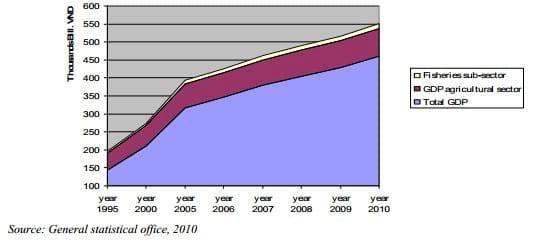
Located in the Red River Delta, Hai Duong is a agricultural province base on many favorable aquatic resources with about 10,000 ha of aquaculture area. Consequently, tilapia farming movement in Hai Duong had taken place strongly since creation of GIFT tilapia which improved the quality of tilapia strains in 2000. In freshwater aquaculture, tilapia is considered a low-cost operation with good financial returns which have incentives for poor farmers in rural areas to culture these fishes in small seasonal ponds, ditches, particularly low paddy-field which are of little benefits. Tilapia farming are supposed to utilize properly and seasonally, which creates an economic source of food fish and additional income in many rural areas (Abdel-Fattah M. El-Sayed., 2006). In addition, tilapia farming is a self-sufficiency fish harvest initiative specifically designed to enhance food production, produce a nutritional source of food to reduce malnutrition, and encourage economic sustainability with a viable and marketable product (Food for the poor website). This study was designed to investigate the fish aquaculture contribution to food security on assessing the tilapia farming households’ efforts to ensure their food stability, availability, access and utilization.
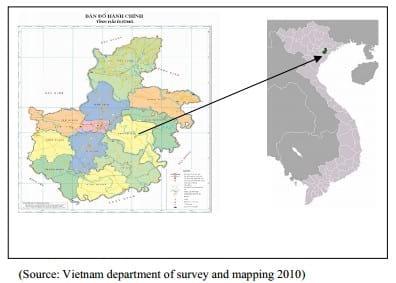
RESEARCH METHODS
Both secondary data and primary data were gathered for this study. The secondary data on general information of Hai Duong province, the basis information related to tilapia farming were gathered from the statistical yearbook of Hai Duong and General statistical office. In addition, 03 focus group discussions with tilapia producers in Hai Duong were held to get their evaluations on the weaknesses and strengths of the tilapia production, and their suggestions for better developing the tilapia farming movement. Furthermore, the direct interviews of 70 and 35 tilapia and none-tilapia households, farms in the preventative conditions and situations of tilapia culture using the questionnaire were implemented in January to March, 2010 to collect the necessary data and information to assess the contribution of aquaculture to food security in Hai Duong province. These data and information include the profile of the households, farms, their agricultural practices, the current income related to their activities and services, the comparative advantages and disadvantages to tilapia production in terms of home consumption, employment opportunity, aquaculture revenues, income generated analyzed on stocking density and/or intensification level, achievements, and farmer perception of profitability and feasibility on tilapia farming. The study mainly used methods of descriptive statistics and comparative analysis.
RESULTS AND DISCUSSION
Hai Duong is located in the center of North Vietnam. It has one city under province and 11 districts with natural area of 165 thousand ha, of which agricultural land accounts for 53.5% or around 88,400 ha. It has a total population of 1,708,000 persons, of which rural population accounts for 80.9% in 2009. The majority of its labor forces (approximately 70%) still engages in agricultural sector despite recent reduction. In recent years, Hai Duong has pushed up developing agriculture and industrial production in the direction of economic and industrialization and modernization. Thus, its GDP growth reached at 11.5% a year in the period of 2006 – 2010 and its agricultural GDP growth recorded at 4.5% (Hai Duong Statistical office, 2010) while the whole of Vietnam, these figures were around 6.7% and 3.3% respectively (General Statistical office, 2010).
Characteristics of survey households
In recent years, Hai Duong has oriented to develop the aquaculture as one of its development strategy which utilized properly its comparative advantages of natural resources. Initial establishment, many households have transformed their low paddy-fields to aquaculture production base on local authorities’ orientation and master planning. This creates a new type of farmer – tilapia farmers who culture the tilapia fish. These tilapia households own many attributes that differed with the traditional farming households characteristics presented in Table 1. Tilapia farmers are more active, educated, younger and less experienced than non-tilapia farmers. Except for attributes of household size, around 4.5 persons, and landholdings, approximately 0.34 ha per farm. Almost tilapia farmers completed their secondary school level (9 years), while none-tilapia spent 7.1 years in education. Non-tilapia households had several advantaged characteristics such as longer experience in occupation, availability of land for the rent in and the rent out. In addition, about 90% of tilapia farmers engaged in rice production as their major occupation. On the other hand, most respondents (85%) were born in their villages.
Table 1. Characteristics of surveyed households

Furthermore, analytical results of agricultural land show that the amount of land owned by both surveyed groups seems not to be differentiated; except high demanding for rent in 416 m2 in tilapia households for developing their tilapia production. This also explained a result of the land reform in two recent decades in northern Vietnam, then gardening areas and farmlands, in most cases, were distributed proportionally to individual farms base on their size of family members. However, the allocated land in these surveyed households had particular distinctions which suggested the farmers’ knowledge, experience and skills in their production. Thus, land was diversified used for many agricultural practices such as: cultivation (rice produce, perennial-fruit crops, vegetable and fish aquaculture, while most land (9 Sao or 3,252 m2) was employed for rice production in non-tilapia households. Only average 2 Sao(1 sao = 360m2 ) for rice production was investigated in tilapia households.
Fish aquaculture contribiution to food security
Fish and all other aquatic products contribute to food security directly as notorious human food providing protein, essential amino acids not found in the stables, calcium, iodine and several vitamins, minerals. In Hai Duong, fish aquaculture assists food security by providing income for fish farmers and livelihood for workers in aquaculture, traded supply and services industries such as feeds, extension, hatcheries, and so forth. Three dimensions of food security - sustainable supply, access to food, and nutritional adequacy – are now each addressed in following paragraphs.
Sustainable food supply
The provision of inland aquatic resources to food supply is deteriorating as increasing the gap between supply of and demand for. Supply is static at best, while demand continues to grow. To prevent such a situation from deteriorating further, the resource employed for aquaculture production must be kept in healthy, functioning order, even more expansion in under-exploited traditional regions. To be food secure, a population, household, or individual must have access to adequate food at all times. Thus food should be accessible all year round, irrespective of the political or economic situation. Particularly, aquaculture has reduced the vulnerable level of environmental shocks such as droughts and floods. The trend on land transformation in traditional agricultural food production to aquaculture production has taken place in the whole country and particular strongly in Hai Duong province. The results reveal the facts that most aquaculture areas employed economically have been conversed to be those from low-paddy fields which is susceptible to environment shocks, especially during the flooding season (Table 2). Annually, the planted area of paddy has been reduced at 1.62% in the period 2002 - 2009. In contrast, the aquaculture area had an upward trend, 4% a year through the period. This phenomenon can be considered a positive evidence for aquaculture contribution to food security in term of availability of food fish; stability of food supply as well as generating more income for sustainable aquaculture farmers in Vietnam.
Table 2. Aquaculture land transformation from traditional agriculture (rice) production
Access to food
Many studies have shown that aquaculture give direct access to the household food supply in those low-income households that begin to grow their own fish and depending on proximity to markets and quantities of fish produced, and also contributes to improve their income and/or barter trade.
From findings of the study, tilapia farmers partially harvest for your home consumption during your fish production cycle. In theory, animal protein from fish sources is an extremely vital role for low-income farmers who grow fish that is eaten regularly at home. In Hai Duong, 97% of respondents reported that fish produced was consumed in the household (3.9% of total production or 533 kg per year) which gives a great contribution to their daily diet in improving the micro micronutrients, the rest being sold at farm gate or at the local market. Aquaculture thereby improved not only access to food by direct growing of fish for food security but also generating income to purchasefoods and other needs such as housing, education, and medical services thereby reducing poverty (Table 3).
Table 3. Annual productivity, revenues, costs and profitability for tilapia production in Hai Duong
Almost all tilapia farmers agreed that tilapia aquaculture increased fish consumption from 0.5 kg per person per month to 1.5 kg per person per month as a result of growing fish; and their economic situation improved by 40% from the sales. Analytically, tilapia is a kind of fish with short production cycles, which require low inputs and therefore little capital investment. That is suitable to both self-sufficient farming and commercial systems. Therefore, tilapia production has increased dramatically over the last decade in Hai Duong. However, the increasing availability of seed and the rising price of fish could cause its larger scale and more intensive cultivation in commercial production.
Fish production may bring additional benefits if it enables households to rise above subsistence farming level and into more commercial scales of operation. Tilapia households income (VND1 87 million) is 1.4 times as much as non-tilapia households (Table 4). The figure was analyzed in generating income from households’ activities on their practices. Obviously, aquaculture value gives the greatest contribution to their total income at the tilapia group (75.5%), while in non-tilapia family the income generated from cultivation accounted for 50% of the total. Moreover, off-farm activities have a significant importance in money creation in the family without tilapia production.
Table 4. The structure of income at the surveyed households

Aquaculture production seems to lead definitely to greater direct access to food, including fish for home consumption by poor people and for outcomes of food security when the income generated from aquaculture are examined by household classification (Table 5). Fish production usually requires high capital inputs, technical know-how, and ownership of or access to land/water resources. Basically, the richer tilapia farms are, the more significant fish income is. In Vietnam, the survey results show that fish aquaculture have benefited to the middle (VND 52 million, more than 2 times against the poor group) and large-scale (rich) commercial farmers (more than 4 times from the middle group). Although the total income in the poor group had the smallest amount, the figure is still higher above the Vietnamese national poverty line 2 and clearly aquaculture contributed to a considerable significance to their living, 51%. Most of them are happy and find fish aquaculture as a crucial instrument for poverty reduction and current economic improvement.
Table 5. The structure of tilapia household's income by household classification
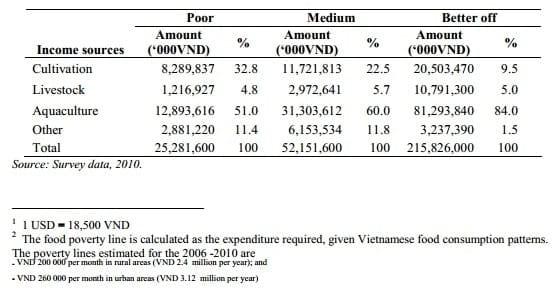
Aquaculture also can improve access to food by those who labor for wages on larger enterprises and in ancillary activities and who thereby gain income. The employment estimated base on man-day per ha per year are presented in Table 6. The estimation of job creation in rice production recorded at 168 man-day per ha per year, while tilapia farming can provide more opportunities of jobs, 257 man-day per ha per year, which gives a meaningful contribution to the employment strategy in rural areas in Vietnam. Hai Duong annual report on socio-economic implementation indicated that the seasonal unemployment rate of rural labors reached at approximately 30%. The study shows that most tilapia households (70%) reported to self-employed their own family labors. Furthermore, in largerscale (commercial) farms, 60% respondents stated that hired labors were used for their tilapia production. The monthly salary for fish workers was from VND 3 to 3.5 million.
Table 6. Job creation in tilapia households by production intensification
Nutritional adequacy
The nutritional adequacy of food supply relies on fish production changing in parallel with the human population density in Hai Duong, whereas aquaculture production per caput increases and maintains food availability. Particularly, statistical data in Vietnam indicates the significant progress in raising food consumption of aqua cultural products per person in the period 1995 – 2009 (see Figure 2). Aquaculture consumption have increased to 30 kg per person per year in 2009 from 5.4 kg per person per year in 1995 in the whole country, and to 29.04 kg per person per year from 2.7 kg per person per year in Hai Duong, respectively. The World Fish Center analysis estimates demand responses to changes in fish price and income.
Fish consumption also shows the variation in term of type and price according to a rural/urban divide. The annual fish consumption per capita is generally higher in rural than in urban (Dey et al.2005). Among rural consumers, fish producers consume more than non-producers. Tilapia has priorities in consumer choice of a particular species since freshwater fish often have lower prices than marine fish, even in cultured fish such as common carp, grass carp… From the Poor’s demand for fish and its availability to them, it is apparent that it is affected not just by availability of, and preferences for fish. Where fish stocks are in decline and demand is high, the price of fish, particularly wild fish, has increased to the extent that the poor can no longer afford to eat what they caught. In such cases, they may eat cultured fish (tilapia) or not eat fish at all, substituting it with other foodstuffs e.g. pork, beef, chicken … The availability of nutritious alternatives to fish then become a vital consideration.
On the other hand, increased supply of fish from aquaculture has led to decrease in price of farmed fish in local and neighboring markets. This tilapia fish culture increases the supply of affordable fish, thereby reducing the cost and increasing the availability of fish to poorer households. The average price paid for fish also increases as income increases. Not surprisingly, poorer households consume lower value fish than the rich. However, despite the lower cost of the fish they purchase, the share of fish expenditure of total animal protein is still higher for poorer households.This indicates the importance of fish in diets of poor people, primarily due to the higher cost of other sources of protein.
Fig. 2 Aquaculture production per caput in Vietnam 1995-2009
The study results show that annual growth of aquaculture production per caput in Hai Duong rising close to the extent of whole country and more rapidly than the Red river delta region. This also suggests the importance of food fish in people’s daily intake as well as the nutrient adequacy in the food security. It is suggested that deeper understanding of the fish utilization and its share of micronutrients and animal protein in farmers’ daily meals.
Fig. 3. Relationship between poverty and presence of aquaculture production in Hai Duong 1990-2009
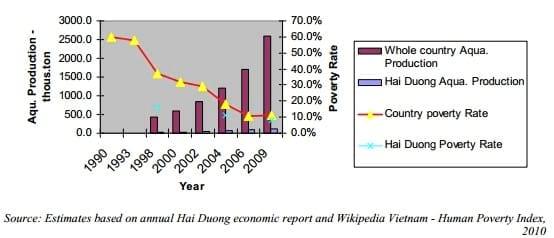
The effective utilization of food is an important aspect of food security and relies on sufficient energy consumption and a varied diet to provide required micronutrients. Therefore, the energetic contribution of aquaculture products could be assessed in terms of calorific importance. Several studies proved that aquaculture has improved life expectancy, growth, fertility in the poor households under aspects of nutrient adequacy. Nonetheless, the aquaculture contribution to food security can be evaluated by examining the decreasing poverty rate to the presence or absence of aquaculture. Figure 3 shows the downtrend in poverty rate in the years 1990 – 2009 in parallel with rapidly rising aquaculture production. The national poverty rate fell to 11% in 2009 from 60% in 1990. In Hai Duong, the poverty rate decreased by 4.5% from 1998 to 2004 and recorded at under approximately 8% in 2009. The surveyed results also reported the coincidental answer in the profitability and feasibility in tilapia aquaculture (Fig. 4)
Fig. 4. Farmer perception on the profitability and feasibility of tilapia farming in Hai Duong (percentage of farms)
The performance perception of tilapia farming in relation to other sources of income varied amongst farmers. Figure 4 shows how it was perceived as more profitable and feasible (viable for tilapia production in relation to knowledge, effort and time demanded and market opportunities) for the majority of the farmers (81.43% claimed to be more profitable, and 78.57% claimed to be more feasible); however, more farmers claimed tilapia farming was less feasible (8.6%) compared to the other sources of income, while only 7% claimed it was less profitable.
CONCLUSION
In Vietnam, the strong movement of inland fish aquaculture development has been taken widespread to ensure availability of food fish (30 kg/person/year in 2009) with annual fish consumption growth recorded at 13.05% (1995-2009). Similarly, Hai Duong has an aquaculture area of 10.000 ha, 4% increasing in annual area growth in 2009. This has annually created remarkable value contribution to its agricultural GDP (2,140 VND billion, occupying for 24.3% of total GDP).
Like Hai Duong, in many other provinces, has favorable conditions to develop the tilapia farming. These help Hai Duong farmers to utilize better the resources to improve their living standards. Tilapia culture could get high yield about 14 tons/ha, equivalent to a revenue of 300 VND million, generating net farm income about 87 VND million (4,724 USD) per ha a year, much more efficient than traditional rice production (only 66 VND million). The tilapia farmers’ economic and food conditions has been improved. However, the increasing availability of seeds (fingerlings), the appropriate control of inputs, and access to capital investment (ownership, loans) would be highly appreciated for enhancing the aquaculture contribution to the poor farmers’ income and food security.
Freshwater aquaculture plays an important role in stabilizing the fish food regarding to scarcity of fish capture. Aquaculture production per caput has increased from 2.7 to 29 kg per person per year (1995-2009). It is also an effective solution for overty reduction and hunger elimination in Vietnam. The aquaculture production increased as the poverty rate deceased, correspondingly.
REFERENCES
Abdel-Fattah M. El-Sayed. 2006. Tilapia Culture. The Role of Tilapia culture in Rural Development. pp. 176-191.CABI publishing. 293 pages.
Ahmed, M. 1999. Policy issues deriving from the scope, determinants of growth, and changing structure of supply of fish and fishery products in developing countries. Fisheries Policy Research in Developing Countries: Issues, Priorities and Needs (eds. M. Ahmed, C. Delgado, S. Sverdrup-Jensen and R.A.V., Santos), pp. 37-57. ICLARM, Manila, Philippines.
Ahmed, M. and Lorica, M.H. 2002. Improving developing country food security through aquaculture development: lessons from Asia. Food Policy, 27, 125-141.
Ali, M. and Delisle, H.F. 1999. A participatory approach to assessing Malawi villagers’ perception of their own food security. Ecology of Food and Nutrition, 38, 101-121.
Bouis, H. 2000. Commercial vegetable and poly-culture fish production in Bangladesh: their impacts on household income and dietary quality. Food and Nutrition Bulletin, 21, 482-487.
Dey, M.M., Briones, R.M. and Ahmed, M.2005. “Disagreed Analysis of Fish Supply, demand and Trade in Asia: baseline Model and Estimation Strategy” Aquaculture, Economics and management, 9(1/2): 113-139.
FAO. 2003a. The Role of Aquaculture in Improving Food Security and Nutrition. Committee on World Food Security, Food and Agriculture Organization of the United Nations, Rome.
Food for the poor Inc. 2008. Article of Tilapia farming for projects development in developing countries. access dated: 24/02/2010. www.foodforthepoor.org.
FSIEWS. 2001. Handbook for Defining and Setting up a Food Security Information and Early Warning System. FAO, Rome.
General Statistics Office, 2010. Statistical Yearbook of Vietnam 2009. Statistical Publishing House, Vietnam, 823 pages
Hai Duong Statistics Office, 2010. Statistical Yearbook of Hai Duong province 2009. Statistical Publishing House, Vietnam. 352 pages
Kent, G. 1997. Fisheries, food security, and the poor. Food Policy, 22, 393-404.
Maxwell, D., Ahiadeke, C., Levin, C., Armar-Klemesu, M., Zakariah, S. and Lamptey, C.L. 1999. Alternative food-security indicators: revisiting the frequency and severity of ‘coping strategies’. Food Policy, 24, 411-429.
McKinsey, K. 1998. Struggles with salmon. Scientific American Presents the Oceans, 9, 68-69.
Pérez-Sánchez, E. and Muir, J. 2003. Fishermen perception on resources management and aquaculture development in the Mecoacan estuary, Tabasco, Mexico. Ocean and Coastal Management, 46, 681-700.
Sigot, A.J. 1998. Food Security in sub-Saharan Africa: the role of governmental and nongovernmental organisations. HUGG International Symposium, Durban, South Africa.
Sverdrup-Jensen, S. 1999. Policy issues deriving from the impact of fisheries on food security and the environment in developing countries. Fisheries Policy Research in Developing Countries: Issues, Priorities and Needs (eds. Ahmed, M., Delgado, C., Sverdrup-Jensen, S., Santos, R.A.V.), pp. 73-91. ICLARM, Manila, Philippines.
Williams, M.J. 1999. The role of fisheries and aquaculture in the future supply of animal protein. Sustainable Aquaculture: food for the future? (eds N. Svennevig, H. Reinertsen and M. New), pp 5-18. Balkerma, Rotterdam.



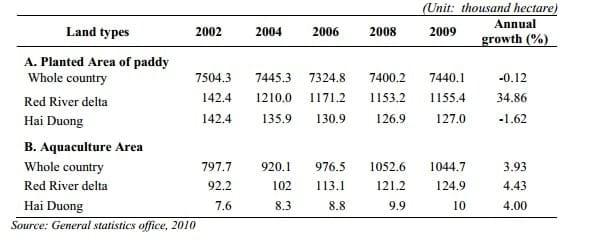
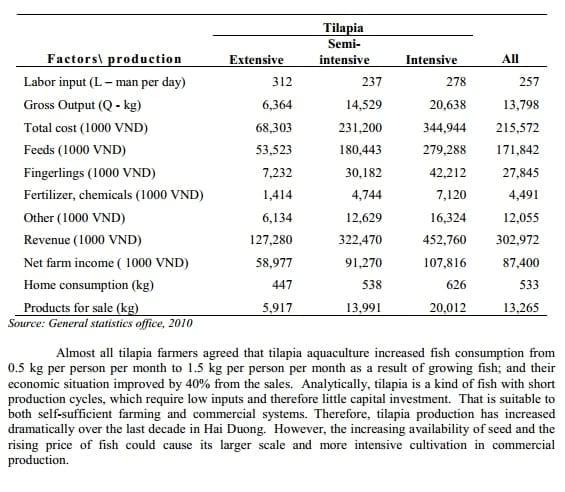



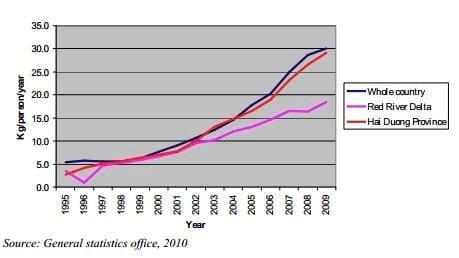





.jpg&w=3840&q=75)